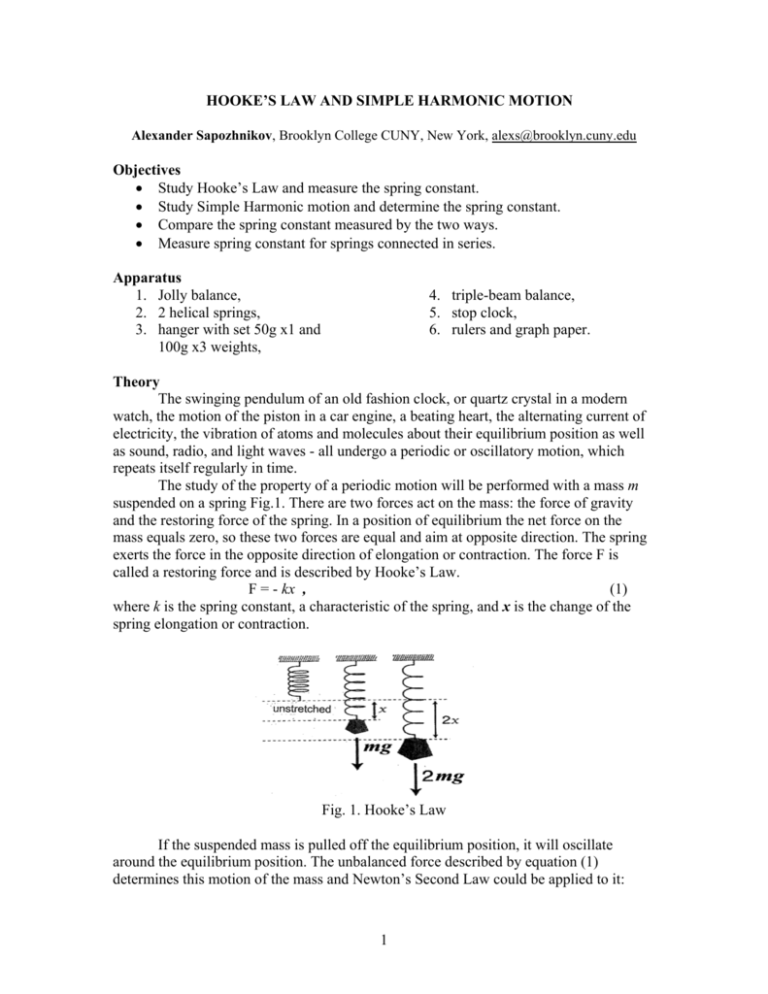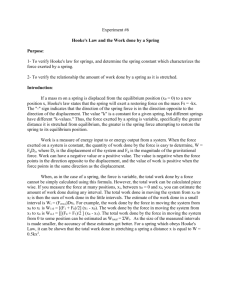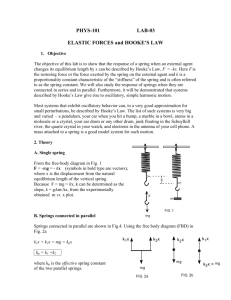Hooke's Law and SHM
advertisement

HOOKE’S LAW AND SIMPLE HARMONIC MOTION Alexander Sapozhnikov, Brooklyn College CUNY, New York, alexs@brooklyn.cuny.edu Objectives • Study Hooke’s Law and measure the spring constant. • Study Simple Harmonic motion and determine the spring constant. • Compare the spring constant measured by the two ways. • Measure spring constant for springs connected in series. Apparatus 1. Jolly balance, 2. 2 helical springs, 3. hanger with set 50g x1 and 100g x3 weights, 4. triple-beam balance, 5. stop clock, 6. rulers and graph paper. Theory The swinging pendulum of an old fashion clock, or quartz crystal in a modern watch, the motion of the piston in a car engine, a beating heart, the alternating current of electricity, the vibration of atoms and molecules about their equilibrium position as well as sound, radio, and light waves - all undergo a periodic or oscillatory motion, which repeats itself regularly in time. The study of the property of a periodic motion will be performed with a mass m suspended on a spring Fig.1. There are two forces act on the mass: the force of gravity and the restoring force of the spring. In a position of equilibrium the net force on the mass equals zero, so these two forces are equal and aim at opposite direction. The spring exerts the force in the opposite direction of elongation or contraction. The force F is called a restoring force and is described by Hooke’s Law. F = - kx , (1) where k is the spring constant, a characteristic of the spring, and x is the change of the spring elongation or contraction. Fig. 1. Hooke’s Law If the suspended mass is pulled off the equilibrium position, it will oscillate around the equilibrium position. The unbalanced force described by equation (1) determines this motion of the mass and Newton’s Second Law could be applied to it: 1 F = ma (2) Substituting the Hooke’s Law (1) for the force one obtains ⎛k⎞ - kx = ma or a = − ⎜ ⎟ x (3) ⎝m⎠ Equation (3) can be rewritten by defining ω2 = (k/m) and taking the acceleration as d 2x second derivative a = as the differential equation dt 2 d 2x + ω2x = 0 (4) 2 dt which is the equation of Simple Harmonic Motion (SHM). The solution of the equation for the position x is a periodic function of time t (see Fig. 2) x(t) = A cos ( ωt + φ ) (5) where A is the amplitude, or maximum displacement, of the periodic motion, ω is the angular frequency, φ is the initial phase angle that depends on the initial displacement of the mass. The angular frequency ω is measured in radians/second and related to the frequency f of the oscillation, which is the number of oscillations per second in units of hertz (Hz). or f = ω / 2 π (6) ω=2πf The time of one complete cycle is the period T and its reciprocal is the frequency m T = 1/f = 2 π (7) k Fig. 2. Simple Harmonic Motion Equation (5) represents the displacement x away from the equilibrium position of a mass undergoing SHM. The velocity and the acceleration of the motion in this case are described by the equations v = - Aω sin( ωt + φ ) (8) (9) a = - Aω2 cos( ωt + φ ) The total energy of the SHM is sum of the spring potential and moving mass kinetic energy 1 2 1 2 1 2 1 1 (10) kx + mv = kA cos2(ωt + φ) + m A2ω2 sin2(ωt + φ) = kA2 2 2 2 2 2 2 The value of the energy is constant and depends on the spring constant and the amplitude of oscillation and not the suspended mass. During the SHM the energy periodically converts from potential energy to kinetic back and forth, but the total value stays the same. In this consideration the mass of the spring was neglected. For a real system the mass should be replaced with the effective mass m spring meff = m + (11) 3 The period (7) for real spring is equal to m spring m+ 3 (12) T=2π k Springs are a common part of many mechanical devices. There are two main basic combinations of usage modes of springs: series and parallel. In the series mode the beginning of one spring is connected to the end of other Fig. 3. In the parallel mode the beginnings of both springs connect to each other and the end too. The combined spring constant for two springs connected in series with spring constants k1 and k2 is determined to be kk 1 1 1 = + or kseries = 1 2 k1 + k 2 k series k1 k 2 (13) For parallel connected springs, the combined spring constant is kparallel = k1 + k2 (14) Fig.3 Series and parallel spring connection In this experiment we use the Jolly balance, which was invented by German physicist Philipp von Jolly in 1864. It consists of a spring fastened at the top to a movable arm with Vernier scale Fig.4. 3 Procedure 1. Weigh a spring using the triple-beam balance and write down the result in Table 1. Check that the hanger mass is 0.05 kg. 2. Set the scale of the Jolly balance to zero position, hang the spring on its arm, adjust the pointer tip of the balance to the spring’s lowest edge, and lock in the position of the pointer. Fig. 4. Set of the experiment with Jolly balance 3. Hang 0.10 kg, the hanger with 0.05 kg weight, to the spring. Raise the Jolly balance using the knurled wheel until the lowest edge of the spring is at the pointer tip. Read and record the scale of the Jolly balance to one-tenth of a millimeter, using the Vernier. 4. Repeat Step 3 for 0.15, 0.20, 0.25, 0.30, 0.35, 0.40 kg loads of the spring. 5. Turn off the pointer from the spring and load 0.10 kg on the spring. Slightly hit the hanger to make it oscillate with small amplitude. Measure and record the time for 10 complete oscillations. 6. Repeat Step 5 for 0.15, 0.20, 0.25, 0.30, 0.35, 0.40 kg loads of the spring. 7. Repeat Steps 1-6 for the second spring and write down the results in Table 2. 8. Repeat Steps 1-6 for series connection of the springs and write down the results in Table 3. 4 Computation and data analysis 1. Calculate the hung weight, the spring constant, and the theoretical period of oscillation T theor (7) for each trial. 2. Calculate the experimental period of oscillation T exp, its square T2exp, and compare it to T theor . 3. For each Table plot a graph: hanged weight vs. spring elongation and find a slope. The value of the slope equals the measured spring constant for Hooke’s law kHooke’s. 4. For each Table plot a graph: hung mass vs. experimental period square T2exp and find slope and y-intercept of it. Calculate spring constant for SHM which equals kSHM = 4 π2*Slope. Compare values of kSHM and kHooke’s . Compare the value of yintercept to one-third of the spring mass. 5. For series connected springs calculate the theoretical value kseries (13) and compare it to the average experimental value. Questions 1. The measurements of the spring constant by two different methods give different units [kHooke’s] = 1 N/m and [kSHM] = 1 kg/s2. Prove that 1 N/m = 1 kg/s2. 2. If the experiment is performed on the Earth and on the Moon, would the results of the spring constant and period of oscillation be the same? Explain. 3. Derive the effective spring constants for series (13) and parallel (14) connections of springs. 5 Student’s name __________________________________ Date _____________ HOOKE’S LAW AND SIMPLE HARMONIC MOTION Table 1. m kg Spring 1 F=m*g N x m mspring1 = ________ kg k =F/x N/m t of 10 osc. s Texp s Texp2 s^2 Ttheor s %diff 0.100 0.150 0.200 0.250 0.300 0.350 0.400 Slope of the graph F vs. x _________ N/m Slope of the graph m vs. Texp2 = ________kg/s2 Average k1 =____________ kg/s2 k1hooke's = ________N/m k1shm = 4*π2*Slope = ________kg/s2 % diff.k1 = ________________ % [y] intercept of the graph m vs. Texp 2 = ______ kg msp1/3 = __________ kg %diff. msp1 /3 = ___________% Table 2. m kg Spring 2 F=m*g N x m mspring2 = ________ kg k =F/x N/m t of 10 osc. s Texp s Texp2 s^2 Ttheor s %diff 0.100 0.150 0.200 0.250 0.300 0.350 0.400 Slope of the graph F vs. x _________ N/m Slope of the graph m vs. Texp2 = ________kg/s2 Average k2 =_______________ kg/s2 k2hooke's = ________N/m k2shm = 4*π2*Slope = ________kg/s2 % diff.k2 = ________________ % [y] intercept of the graph m vs. Texp 2 = ______ kg msp2/3 = __________ kg %diff. msp2 /3 = ___________% 6 Table 3. Springs 1 and 2 in series mspring1 = ________ kg m kg F=m*g N x m k =F/x N/m mspring2 = ________ kg t of 10 osc. s Texp s Texp2 s^2 Ttheor s %diff 0.100 0.150 0.200 0.250 0.300 0.350 0.400 Slope of the graph F vs. x _________ N/m Slope of the graph m vs. Texp2 = ________kg/s2 Theoretical kseries=k1*k2/(k1+k2) = ____________________kg/s2 7 khooke's = ________N/m kshm = 4*π2*Slope = ________kg/s2 Average k =_______________ kg/s2 %diff. = ________






